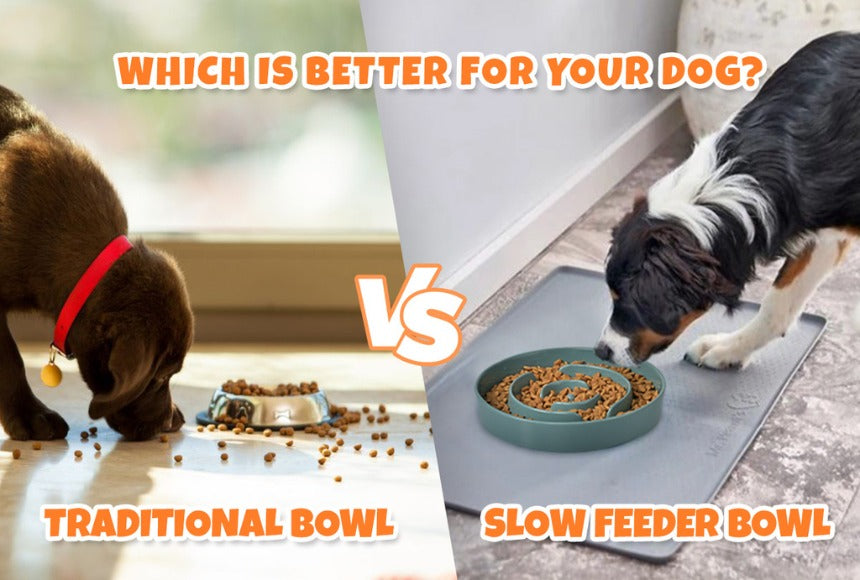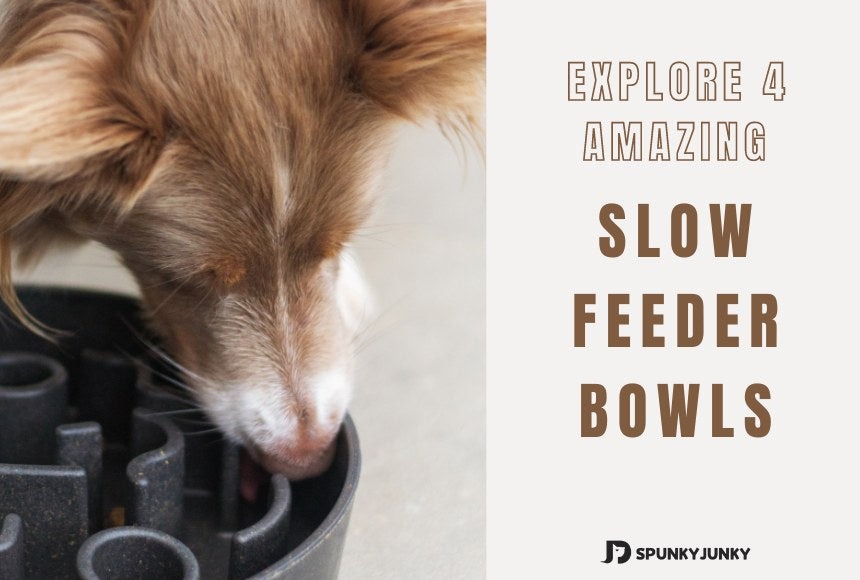Are you curious about the difference between slow feeder bowls and traditional dog bowls?
In this article, we'll explore traditional and slow food dog bowls to see which is better for your dog. We'll take a closer look at their features, benefits, and how they can make mealtime more exciting for your four-legged companion.
Get ready to enter the world of dog dining. Let's get started!
What are Slow Feeder Bowls?

Slow Food Bowls are special dog bowls that help dogs eat healthier. It's designed to make sure they don't eat too quickly.
These bowls have cool designs with obstacles, mazes, or raised sections to make eating fun for dogs. The idea is to slow their eating rate so they can eat smaller, easier meals. This helps them chew their food correctly. When dogs eat too quickly, it can upset their stomachs and cause problems.
So the Slow Food Bowl is like a conductor that helps dogs eat at the right pace and keeps their tummies happy and healthy.
Types of Slow Feeder Bowls
Slow Feed Bowls are a great new way to make your dog's mealtime more exciting.
Let's explore some of the different types of slow food bowls that can help your dog enjoy food at a comfortable pace:
Slow food bowls are made to do the same thing, no matter which types you choose: control how fast your dog eats and help their gut health.
Pros of Slow Feeder Bowls for Dogs
Now that we've explored the different types of slow food bowls, let's dig into the remarkable benefits they offer our furry friends.

In conclusion, Slow Food Bowls provide an easy and effective way to take care of our dogs' health while ensuring they have a satisfying and stimulating dining experience.
What are Traditional Dog Bowls?

Traditional dog bowls are conventional feeding bowls used for years to provide food and water to dogs.
These bowls are usually made of materials like plastic, ceramic, or stainless steel and come in various sizes and shapes. They have a flat or slightly raised base with sloping sides that help contain the food or water.
Traditional dog bowls are simple in design and serve the basic purpose of providing a designated space for dogs to eat and drink. They are widely available and come in different colors and patterns to suit personal preferences.
Pros and Cons of Traditional Dog Bowl
Traditional dog bowls have been widely used for feeding dogs, and they come with their own set of advantages and disadvantages. Here are some pros and cons of traditional dog bowls:

1. Pros of Traditional Dog Bowls:
● Accessibility: Traditional dog bowls are easily accessible and can be found in pet stores, online, or in general retail stores.
● Familiarity: Dogs are generally familiar with traditional dog bowls, as they have been commonly used for many years.
● Variety: Traditional dog bowls come in different sizes, shapes, and materials, allowing pet owners to choose the one that suits their dog's needs and preferences.
● Affordability: Compared to some specialized feeding options, traditional dog bowls are often more affordable.
2. Cons of Traditional Dog Bowls:
● Inability to Regulate Eating Speed: Some dogs tend to eat too quickly from traditional dog bowls, which can lead to issues like indigestion, bloating, or obesity.
● Neck Strain: Dogs with certain health conditions, such as arthritis or neck problems, may find it uncomfortable to eat from a bowl placed on the floor, as it requires them to bend their necks.
● Mess and Spills: Traditional dog bowls can be prone to spills and mess, especially if the dog is enthusiastic or has a tendency to push the bowl around.
● Hygiene Concerns: If not cleaned regularly, traditional dog bowls can accumulate bacteria and become unhygienic.
Slow Feeder Bowls vs. Traditional Bowls: Which is Better for Your Dog?
We've discussed the good things about slow-feeder bowls, let's compare them to regular bowls to see which is better for your pet.

According to the table above, slow feeder bowls have many advantages over traditional bowls.
The Slow Food Bowl helps dogs eat slower, chew better, and digest food properly. It also helps them know when they are full so they don't overeat. On the other hand, traditional bowls don't encourage dogs to eat slowly or chew their food properly, which can make them overeat.
Slow feeder bowls are also good for dogs' digestion and can help prevent stomach problems. Traditional bowls don't have special features for digestion.
Slow-feeder bowls also make mealtime more fun and exciting for dogs. They have puzzles or obstacles that challenge dogs to get food, keeping them entertained. Traditional bowls don't have these fun features.
Traditional bowls are easier to clean because they have no complicated parts. They are simple and smooth. Traditional bowls are also less likely to slip or move around because they don't require dogs to use force to get food.
However, slow-feeder bowls can be more expensive than traditional bowls because of their unique design and features. But their benefits are worth the price because they help dogs eat better and stay healthy.
So, a slow feeder bowl could be a great way to make dinner fun for your pet, help them digest food better, and keep them from overheating. It's an investment in your dog's health and happiness.
Conclusion
All in all, slow food bowls are an excellent and helpful tool for our dog! They are much better than traditional dog bowls because they make mealtime fun and healthy.
These individual bowls help dogs eat at a good pace, digest their food correctly, and prevent them from overheating. Plus, they even give our dogs some brain exercise, keeping them entertained while eating!
If you want to learn more about caring for your dog and keeping them healthy and happy, check out our blog. We have many fun and exciting articles that will teach you about being a great pet parent.






